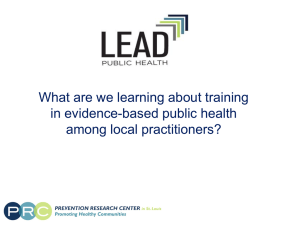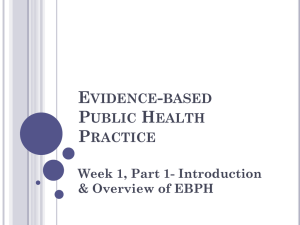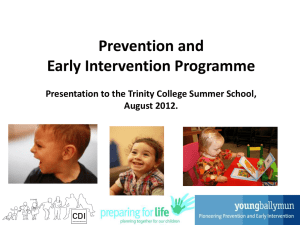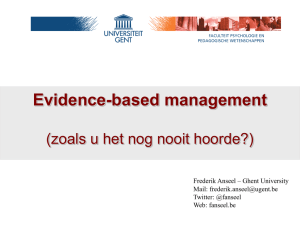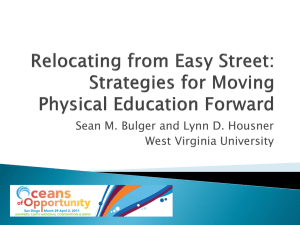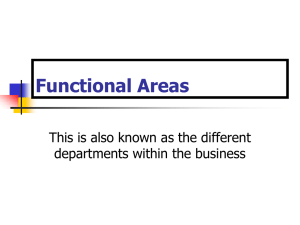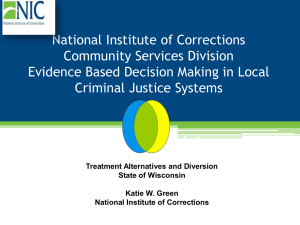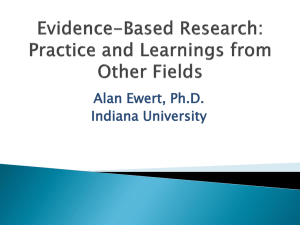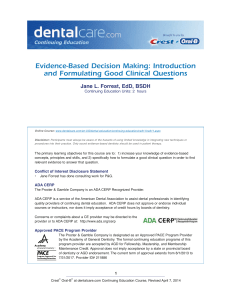Using the Evidence-Base to Improve Local Public Health Practice.
advertisement
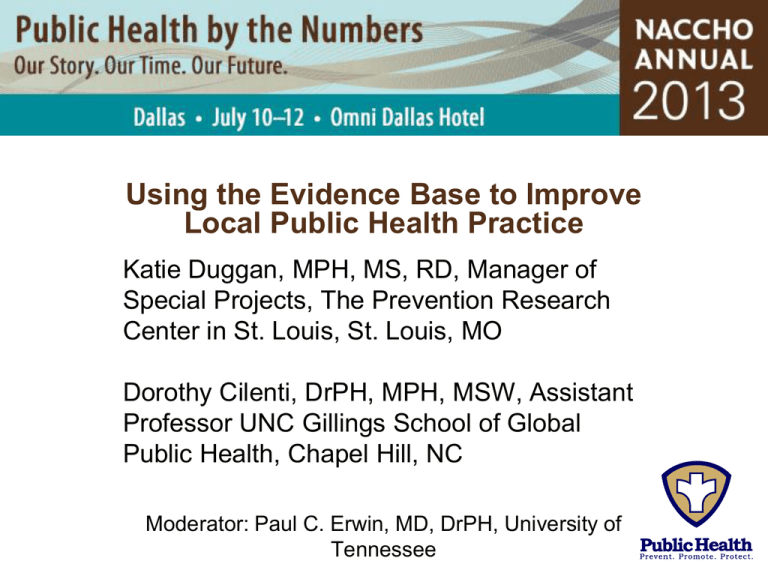
Using the Evidence Base to Improve Local Public Health Practice Katie Duggan, MPH, MS, RD, Manager of Special Projects, The Prevention Research Center in St. Louis, St. Louis, MO Dorothy Cilenti, DrPH, MPH, MSW, Assistant Professor UNC Gillings School of Global Public Health, Chapel Hill, NC Moderator: Paul C. Erwin, MD, DrPH, University of Tennessee Evidence-Based Public Health • The integration of science-based interventions with community preferences to improve the health of populations (Kohatsu ND, Am J Prev Med. 2004) • Relevance to PHAB Standard 10: “Contribute to and apply the evidence base of public health” • Relevance to Essential Service 10: “Evaluates the development, implementation, and impact of LPHS research efforts on public health practice.” Evidence-Based Public Health • What is it? – Evidence-Based Practice – Administrative Evidence-Based Practices – Evidence-Based Decision Making – Practice-Based Research • How is it measured? • Who is involved? • What works? Project LEAD Katie Duggan, MPH, MS, RD, Manager of Special Projects, The Prevention Research Center in St. Louis, St. Louis, MO LOCAL EVIDENCE AFFECTING DECISIONS IN PUBLIC HEALTH Acknowledgements Robert Wood Johnson Foundation National Coordinating Center for PHSSR + University of Kentucky in Lexington Project Team: – – – – – – – – – – – Katie Stamatakis, PhD MPH Rodrigo Reis, PhD MSc Carolyn Leep, MPH Beth Dodson, PhD MPH Katie Duggan, MPH MS RD Paul Erwin, DrPH MD Peg Allen, PhD MPH Ross Brownson, PhD Jenine Harris, PhD Carson Smith, MPA Robert Fields, BS What are we trying to achieve? - “Evidence-based public health is the process of integrating science-based interventions with community preferences to improve the health of populations.” Kohatsu, et al. Am J Prev Med 2004 But, more than only interventions… from PHSSR, administrative EBPs - Agency (health department)-level structures and activities that are positively associated with performance measures (e.g., achieving core public health functions, carrying out evidence-based interventions). What is Project LEAD? 4 Aims: 1. Describe the evidence-base for local EBPH in the United States (esp. A-EBPs) 2. Test the effectiveness of local-level EBPH capacity building in 4 states 3. Describe a range of local models in EBPH 4. Translate and disseminate findings to stakeholders A few early findings for Aim 1 Online survey was sent to 967 LHDs 517 completed surveys were returned (54% response rate) 68% with top health official, 23% with deputy Preliminary Results, 5 EBP domains Workforce development QI (82%), EBDM (59%) Leadership Staff participation (84%) hire w/ PH degree (36%) Organizational climate and culture Life long learning (71%), culture supports EBDM (42%) Relationships and partnerships Importance (92%), share resources (68%) Financial processes Multi funding sources (96%), QI resources (55%) Preliminary Results Patterns of A-EBPs and use of EBDM vary significantly based on: 1. Population size served by the LHD (strongest predictors after adjustment) 2. Governance structure (state governed) 3. Age group in the 50s Use of resources 26% of LHDs reported systematic reviews as 1 of top 3 most important resources 33.5% were not familiar with the Community Guide Most important resources for decision making • Funding guidance (57%) • Guidance from state health agency (53%) • Health Planning tools e.g., MAPP or Healthy People (42%) • Success stories or lessons learned from peers (42%) How do LHDS learn about public health findings? 1. 2. 3. 4. Professional Associations (56%) Seminars or workshops (52%) Email alerts (34%) Academic journals (31%) Top Read Journals 1. American Journal of Public Health (22%) 2. Morbidity Mortality Weekly Report (21%) 3. Journal of Public Health Management and Practice (12.4%) 4. Public Health Reports (10.5%) Evidence-Based Interventions 21% reported EBDM was packaged in a way that is usable 18% felt they are designed in a way to be self-sustaining 25% agreed EBDM is easy to understand in their agency What encourages use of EBDM in LHD’s? • Trainings in EBDM (83%) • High priority placed by Leadership (67%) • Positive feedback or encouragement to use EBDM (45%) • A performance evaluation that considers the use of EBDM (45%) Factors Contributing to Successful Implementation of Evidence-Based Public Health Practice: Findings from Case Studies of Four Local Health Departments Dorothy Cilenti, DrPH, Ross C. Brownson, PhD, Karl Umble, PhD, Paul Campbell Erwin, MD, DrPH, Rosemary Summers DrPH Acknowledgements Funding: University of Kentucky National Coordinating Center for Public Health Systems and Services Research and the Robert Wood Johnson Foundation Project team: The authors would like to recognize Matthew Schnupp, MSPH, BSN, RN for his assistance with the literature review and data collection activities. Study participants: We would also like to thank the local health departments and academic researchers who were interviewed as part of this study. Study Objectives • To describe factors which contribute to successful translation of science to practice in public health agencies Theoretical Framework • Study utilized the Consolidated Framework for Implementation Research (CFIR)* which integrates 19 models of innovation, dissemination and implementation into five domains: – – – – – Intervention Characteristics Outer Setting Inner Setting Individual Characteristics Process of Implementation *Damschroder LJ, Aron DC, Keith RE, Kirsh SR, Alexander JA, Lowery JC. Fostering implementation of health services research findings into practice: A consolidated framework for advancing implementation science. Implementation Science Aug 2009; 4 (50). Methods • Four health departments with special knowledge or insight into the issue of interest were identified through discussions with key informants from PBRNs, PRCs, academic health departments, and the CDC. • The research team conducted structured interviews with key informants in the four health departments and with four corresponding partners from academic institutions. • Interviews were recorded and transcribed, and a thematic analysis of codes was conducted using Atlas TI Description of Case Study Sites • County A: Home to large state university housing a College of Medicine and a state-authority local public health agency with 48 million budget and 640 positions serving a southeastern city with more than 1 million residents. • County B: Home to a large state university housing a College of Public Health and a local public health agency employing 45 individuals in a Midwestern city serving 240,000 residents. The agency has a 5 million dollar budget comprised of 67% local funding. Description of Case Study Sites • City C: Home to a local public health agency employing 258 individuals serving 600,000 residents in a metropolitan area of the Midwest. A large state university housing a School of Medicine and Public Health is located in another city. The agency has an annual budget of 26 million dollars, with 50% of funding from local taxes. • County D: Home to a local public health agency employing 134 individuals serving 300,000 residents in a medium-size metropolitan area in the Northeast. A large private university housing a School of Public Health is located in an urban city approximately two hours from the health department. The agency’s annual budget is approximately 36 million. Findings • Eight faculty members from academic institutions and 14 public health executives and senior leaders were interviewed across the four sites. Several themes emerged that were consistent with the CFIR. Themes • Outer setting: – Health departments and academic partners were WIDELY NETWORKED with external organizations such as NACCHO, PBRNs, etc. – Staff were given ample opportunities to assume BOUNDARYSPANNING ROLES including adjunct appointments; faculty also assumed roles within health departments – Academic departments made INVESTMENTS in faculty engaging in practice-related activities – Decisions to disseminate, adopt and implement EBP was directly related to MEETING COMMUNITY NEEDS and AVAILABILITY OF ADDITIONAL RESOURCES to meet those needs – Implementation of EBP was also driven by EXTERNAL POLICIES AND INCENTIVES, such as federal and state program mandates, accreditation, etc. Themes • Inner Setting: – Health departments established DEDICATED INTERNAL UNITS to provide data support for programs, identify grant opportunities, research evidence-based practices and provide evaluation services. – Health departments hired EMPLOYEES TRAINED IN EPIDEMIOLOGY AND BIOSTATISTICS and extended this expertise to community-based organizations. – Academic institutions funded FORMAL STRUCTURES within their schools to facilitate communication and collaborative work with local health departments – Health departments identified FUNDING FOR STAFF TRAINING AND COMPUTER TECHNOLOGY and allowed time for staff to pursue training. Themes • Process of Implementation: – Health departments and academic partners emphasized the important of ENGAGING LEADERSHIP AND STAFF to implement evidencebased practice – Successful implementation was typically integrated with a QUALITY IMPROVEMENT APPROACH Summary Seven Take-Aways: 1) Link the evidence-based practice to a visible, high-priority community need 2) Maintain strong networks with professional organizations and peers 3) Leverage use of EBP through federal and state program mandates, funding, and accreditation 4) Build strong political support for application of science-driven approaches 5) Invest in dedicated resources and staff for research and data capacity 6) Establish strong communication channels between researchers and practitioners and between agency staff and agency leaders 7) Identify funds for implementation of evidence-based policies and practices. Where to Go from Here • Make use of theory and frameworks • Develop measures to track health department implementation of evidence-based practice • Develop tracer conditions to measure and track over time, such as specific organizational, structural, financial, workforce and governance-related changes • Conduct systems research to identify where practitioners and researchers may make organizational changes to create cultures that facilitate implementation of evidence-based practice Evidence-Based Public Health Discussion • Do the themes from the case studies and project LEAD resonate with you? • Think about health depts. that stand out as leaders in EBDM…..are there other characteristics or factors that seem to help them be high performers in this area? – What has enabled you to utilize EBDM? – What are the barriers to EBDM? – How can we address these barriers? Discussion • What do you currently see as the deficits in training? – How can we address these deficits? – What are your preferred methods for training? – And thinking about a successful training that you have been to, what would you say made that training successful? • What ONE next thing might you do in your health agencies when you leave the conference to move your agency along in EBDM? Using the Evidence Base to Improve Local Public Health Practice Katie Duggan, MPH, MS, RD, Manager of Special Projects, The Prevention Research Center in St. Louis, St. Louis, MO Dorothy Cilenti, DrPH, MPH, MSW, Assistant Professor UNC Gillings School of Global Public Health, Chapel Hill, NC
